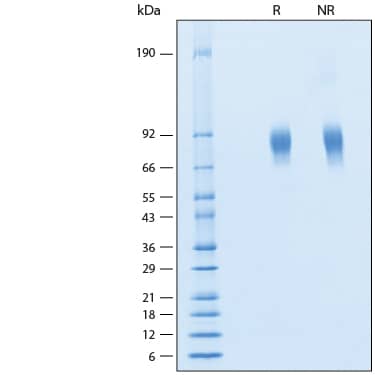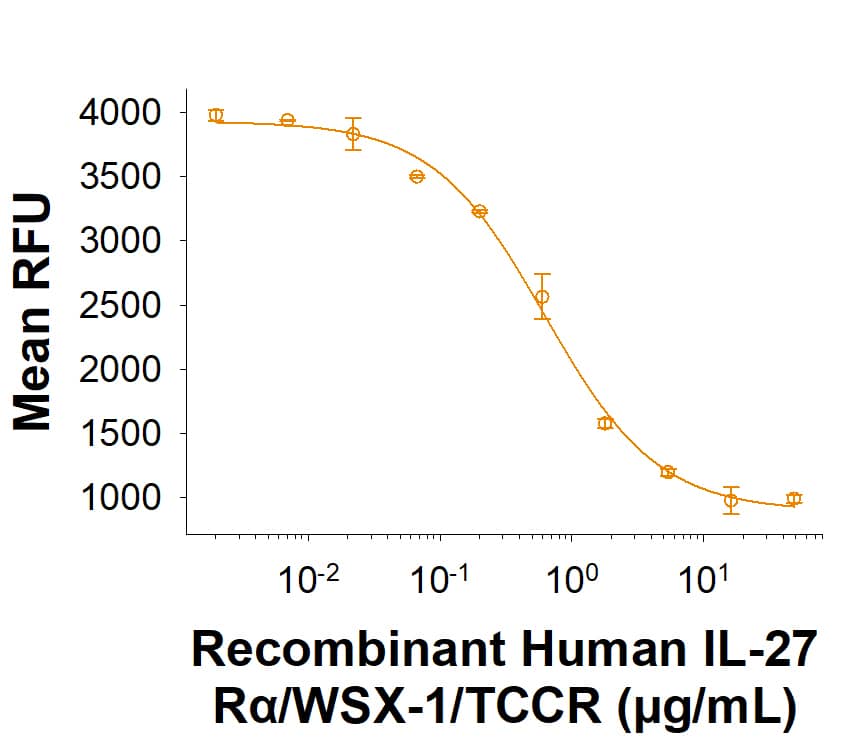Recombinant Human IL-27 Ra/WSX-1/TCCR His-tag Protein, CF
Recombinant Human IL-27 Ra/WSX-1/TCCR His-tag Protein, CF Summary
Product Specifications
Thr30-Lys516, with a C-terminal 6-His tag
Analysis
Product Datasheets
Carrier Free
CF stands for Carrier Free (CF). We typically add Bovine Serum Albumin (BSA) as a carrier protein to our recombinant proteins. Adding a carrier protein enhances protein stability, increases shelf-life, and allows the recombinant protein to be stored at a more dilute concentration. The carrier free version does not contain BSA.
In general, we advise purchasing the recombinant protein with BSA for use in cell or tissue culture, or as an ELISA standard. In contrast, the carrier free protein is recommended for applications, in which the presence of BSA could interfere.
11270-TC
| Formulation | Lyophilized from a 0.2 μm filtered solution in PBS with Trehalose. |
| Reconstitution | Reconstitute at 500 μg/mL in PBS. |
| Shipping | The product is shipped at ambient temperature. Upon receipt, store it immediately at the temperature recommended below. |
| Stability & Storage: | Use a manual defrost freezer and avoid repeated freeze-thaw cycles.
|
Scientific Data
 View Larger
View Larger
2 μg/lane of Recombinant Human IL-27 Ra/WSX-1/TCCR His-tag Protein (Catalog # 11270-TC) was resolved with SDS-PAGE under reducing (R) and non-reducing (NR) conditions and visualized by Coomassie® Blue staining, showing bands at 76-88 kDa.
 View Larger
View Larger
Recombinant Human IL‑27 R alpha /WSX‑1/TCCR His-tag Protein (Catalog # 11270-TC) inhibits IL-27 anti-viral activity in HepG2 human hepatocellular carcinoma cells infected with encephalomyocarditis (EMC) virus. The ED50 for this effect is 0.160-2.40 µg/mL.
Reconstitution Calculator
Background: IL-27 R alpha/WSX-1/TCCR
IL‑27 R alpha (also known as WSX‑1 and TCCR) is a 96 ‑ 100 kDa member of the type I, group 2 cytokine receptor family (1, 2, 3, 4, 5, 6). Mature IL‑27 R alpha is a type I transmembrane glycoprotein that contains a 484 amino acid (aa) extracellular region, a 21 aa transmembrane segment and a 99 aa cytoplasmic domain. Consistent with type I cytokine receptors, the extracellular region contains four positionally conserved cysteine residues, a WSxWS motif (for receptor folding and ligand binding), and three fibronectin type III repeats. The intracellular domain contains a "box‑1" motif that may be involved with Janus kinases (3). One potential alternate splice form has been hypothesized that involves a 58 aa addition to the cytoplasmic domain and, based on mouse, a soluble 33 kDa splice form that shows a 20 aa substitution for aa 257 ‑ 636 may also occur in human (3, 7). The human IL‑27 R alpha extracellular region shares 63% amino acid identity with the mouse IL‑27 R alpha extracellular domain (2, 3). IL‑27 R alpha is expressed in mast cells, endothelial cells, NK cells, macrophages, monocytes, B cells, dendritic cells, and naïve T cells (1, 2, 4, 8). Typical of other class I cytokine receptor chains, the ligand binding IL‑27 R alpha molecule is known to heterodimerize with a signal‑transducing subunit (gp130) to form a functional IL‑27 receptor (9, 10). In addition, IL‑27 R alpha is reported to complex with CNTFR alpha and gp130 form a humanin receptor on neurons (7, 11), and to complex with gp130 and IL‑6 R to form a receptor for a p28:CLF heterodimeric cytokine on lymphocytes (12). Studies using IL‑27 R alpha /WSX‑1‑/‑ mice reveal that IL‑27 has the ability to suppress T cell activity during infection, and to mediate an inhibition of both type 1 and type 2 T cell immunity (4, 13, 14). In particular, IL‑27 is known to act on naïve T cells, blocking their differentiation into a Th17 phenotype. Notably, cells committed to a Th17 phenotype, although they express a functional IL‑27 receptor, are unresponsive to the effects of IL‑27 (15). Activated T cells that are CD4+ and CD8+, and which express the IL‑27 receptor, can be induced by IL‑27 to form a double‑positive CD25+ FoxP3‑ IFN‑ gamma plus IL‑10 secreting phenotype that both promotes and suppresses the inflammatory response (16).
- Villarino, A.V. et al. (2004) J. Immunol. 173:715.
- Chen, Q. et al. (2000) Nature 407:916.
- Sprecher, C.A. et al. (1998) Biochem. Biophys. Res. Commun. 246:82.
- Artis, D. et al. (2004) J. Immunol. 173:5626.
- Yoshida, H. & Y. Miyazaki (2008) Int. J. Biochem. Cell Biol. 40:2379.
- Yoshida, H. & M. Yoshiyuki (2008) Immunol. Rev. 226:234.
- Hashimoto, Y. et al. (2009) Biochem. Biophys. Res. Commun. 389:95.
- Holscher, C. et al. (2005) J. Immunol. 174:3534.
- Pflanz, S. et al. (2004) J. Immunol. 172:2225.
- Scheller, J. et al. (2005) Biochem. Biophys. Res. Commun. 326:724.
- Hashimoto, Y. et al. (2009) Mol. Biol. Cell 20:2864.
- Crabe, S. et al. (2009) J. Immunol. 183:7692.
- Villarino, A. et al. (2003) J. Immunol. 170:645.
- Hamano., S. et al. (2003) Immunity 19:657.
- El-behi, M. et al. (2009) J. Immunol. 183:4957.
- Fitzgerald, D.C. et al. (2007) Nat. Immunol. 8:1372.
FAQs
No product specific FAQs exist for this product, however you may
View all Proteins and Enzyme FAQsReviews for Recombinant Human IL-27 Ra/WSX-1/TCCR His-tag Protein, CF
There are currently no reviews for this product. Be the first to review Recombinant Human IL-27 Ra/WSX-1/TCCR His-tag Protein, CF and earn rewards!
Have you used Recombinant Human IL-27 Ra/WSX-1/TCCR His-tag Protein, CF?
Submit a review and receive an Amazon gift card.
$25/€18/£15/$25CAN/¥75 Yuan/¥2500 Yen for a review with an image
$10/€7/£6/$10 CAD/¥70 Yuan/¥1110 Yen for a review without an image

